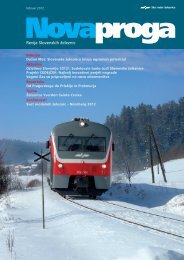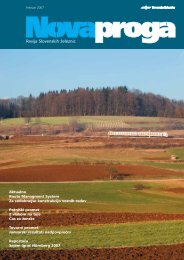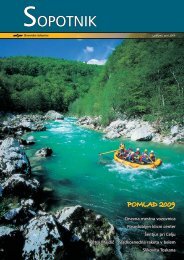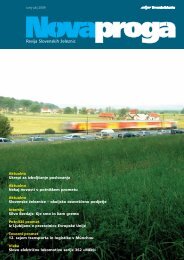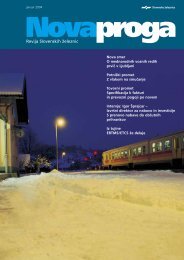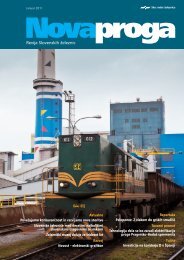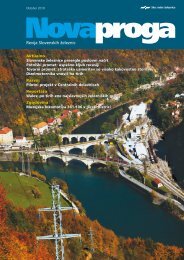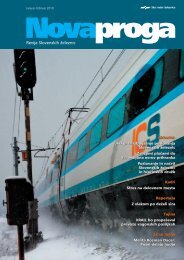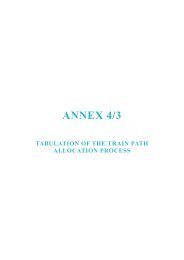Network Statement 2014 - Slovenske železnice
Network Statement 2014 - Slovenske železnice
Network Statement 2014 - Slovenske železnice
- No tags were found...
Create successful ePaper yourself
Turn your PDF publications into a flip-book with our unique Google optimized e-Paper software.
<strong>Slovenske</strong> železnice - Infrastruktura d.o.o. – <strong>Network</strong> <strong>Statement</strong> of the Republic of Slovenia <strong>2014</strong> – 9.12.2012 – 0loudspeaker for hands-free communication.Telephone stations allow the connecting of analogue and ISDN telephone subscribers andconnecting of analogue wires with E&M signalization. Connection to the public telephonenetwork is made on the S2M level through ISDN centrals.Auxiliary telephones, or wallboards, are set up in traffic offices on each station. They areconnected parallel to phone lines and are meant to be used in cases when other systemsbreak down. Bells, switches (assuring selection of individual phone lines) and LB telephonesare mounted on the wallboards as well.Public address system is intended for two groups of users: railroad personnel and passengerson a station. It consists of amplifiers and loudspeakers. It is used for live voice messages,spoken into an STS microphone by the signalman, and for messages of an automatic trainidentification system. This system is connected directly onto the STS or over a transfersystem.Telecommunication call points are intended for the railroad personnel performing their workalong the rail line. Telecommunication call points include LB or CB telephone appliances forvoice communication with traffic or maintenance staff at stations. Call points may be in theform of lockers or columns. The difference between lockers and columns is that the formerhas an additional space where an event logbook can be stored. Lockers are mounted at levelcrossings, entrance or exit signals on the station, station areas, at automatic rail blocks andelsewhere. Columns are built on the open line at a distance of one kilometre apart.Register phones are intended to record conversations on rail lines, radio communicationsand telecommunication boards of train dispatchers.Watch devices are intended to display the right time, both for users of railroad services andfor the PRI employees.The Data network consists of a passive part (wiring) and an active part (Ethernet switchesand routers). One side of the switches is connected to the transfer system, while on the sideof the station systems they enable the local Ethernet network.Automatic train identification system triggers automatic (recorded) spoken messagesdepending on the motion of the trains. The system receives information about the positionof the train from the ILTIS system. On the basis of this information, entered timetable andpre-recorded messages, it triggers the appropriate recording on the corresponding station.The messages inform passengers about regular arrivals and delays of the trains. Messagesare recorded in Slovenian, widespread foreign languages and the languages of theminorities.Emergency call system consists of emergency call systems (SOS columns) which are placed atthe stations, near the area where the passengers are. The system assures direct andimmediate connection between the user and workplace, which is occupied 24 hours per day.The system is for informing of intervention events while, at the same time, it gives the usersaccess to a lot of information. SOS columns are physically connected to the STS eitherdirectly or over the transfer system. Functionally, all connections from SOS columns aredirected to the Traffic Control Centre.PAGE 31



